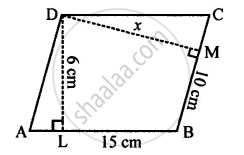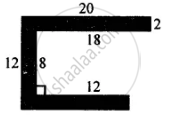Advertisements
Advertisements
प्रश्न
The adjacent sides of a parallelogram are 15 cm and 10 cm. If the distance between the longer sides is 6 cm, find the distance between the shorter sides.
उत्तर
In parallelogram ABCD
AB = DC = 15 cm
BC = AD = 10 cm

Distance between longer sides AB and DC is 6 cm
i.e., perpendicular DL = 6 cm
DM ⊥ BC
Area of parallelogram = Base × Altitude
= AB × DL = 15 × 6 = 90 cm2
Again let DM = x cm
∴ Area of parallelogram ABCD = BC × DM
= 10 × x = 10x cm2
∴ 10x cm2 = 90 cm2
⇒ x = `90/10` = 9 cm
APPEARS IN
संबंधित प्रश्न
A square lawn is surrounded by a path 2.5 m wide. If the area of the path is 165 m2 find the area of the lawn.
In the figure given below, find the area of shaded region: (All measurements are in cm)

Find the area of the rhombus, if its diagonals are 30 cm and 24 cm.
One side of a parallelogram is 18 cm and its area is 153 cm2. Find the distance of the given side from its opposite side.
Find the height of a triangle whose base is 18 cm and the area is 270 cm2.
Find the area of an equilateral triangle whose each side is 16 cm. (Take `sqrt3`= 1.73)
The diameter of every wheel of a car is 63 cm. How much distance will the car move during the 2000 revolutions of its wheel.
A wire is along the boundary of a circle with a radius of 28 cm. If the same wire is bent in the form of a square, find the area of the square formed.
The length and breadth of a rectangular paper are 35 cm and 22 cm. Find the area of the largest circle which can be cut out of this paper.
From each corner of a rectangular paper (30 cm x 20 cm) a quadrant of a circle of radius 7 cm is cut. Find the area of the remaining paper i.e., shaded portion.

